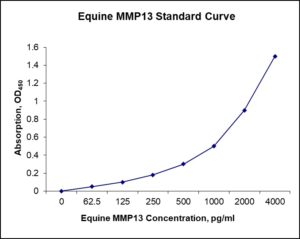Nori Equine MMP13 ELISA Kit
$461.00 – $832.00
This ELISA kit is for quantification of MMP13 in horse. This is a quick ELISA assay that reduces time to 50% compared to the conventional method, and the entire assay only takes 3 hours. This assay employs the quantitative sandwich enzyme immunoassay technique and uses biotin-streptavidin chemistry technique to improve the performance of the assays. An antibody specific for MMP13 has been pre-coated onto a microplate. Standards and samples are pipetted into the wells and any MMP13 present is bound by the immobilized antibody. After washing away any unbound substances, a detection antibody specific for MMP13 is added to the wells. Following wash to remove any unbound antibody reagent, a detection reagent is added. After intensive wash a substrate solution is added to the wells and color develops in proportion to the amount of MMP13 bound in the initial step. The color development is stopped, and the intensity of the color is measured.
Alternative names for MMP13: Matrix metalloproteinase 13
This product is for laboratory research use only, not for diagnostic and therapeutic purposes or any other purposes.
- Description
- How Elisa Works
- Product Citations
- Reviews (0)
Description
Nori Equine MMP13 ELISA Kit Summary
Alternative names for MMP13: Matrix metalloproteinase 13
Alternative names for equine: horse
| Assay Type | Solid Phase Sandwich ELISA |
| Format | 96-well Microplate or 96-Well Strip Microplate |
| Method of Detection | Colorimetric |
| Number of Targets Detected | 1 |
| Target Antigen Accession Number | O18927 |
| Assay Length | 3 hours |
| Quantitative/Semiquantitative | Quantitative |
| Sample Type | Plasma, Serum, Cell Culture, Urine, Cell/Tissue Lysates, Synovial Fluid, BAL, |
| Recommended Sample Dilution (Plasma/Serum) | No dilution for sample <ULOQ; sufficient dilution for samples >ULOQ |
| Sensitivity | 12 pg/mL |
| Detection Range | 62.5-4000 pg/mL |
| Specificity | Equine MMP13 |
| Cross-Reactivity | < 0.5% cross-reactivity observed with available related molecules, < 50% cross-species reactivity observed with species tested. |
| Interference | No significant interference observed with available related molecules |
| Storage/Stability | 4 ºC for up to 6 months |
| Usage | For Laboratory Research Use Only. Not for diagnostic or therapeutic use. |
| Additional Notes | The kit allows for use in multiple experiments. |
Standard Curve
Kit Components
1. Pre-coated 96-well Microplate
2. Biotinylated Detection Antibody
3. Streptavidin-HRP Conjugate
4. Lyophilized Standards
5. TMB One-Step Substrate
6. Stop Solution
7. 20 x PBS
8. Assay Buffer
Other Materials Required but not Provided:
1. Microplate Reader capable of measuring absorption at 450 nm
2. Log-log graph paper or computer and software for ELISA data analysis
3. Precision pipettes (1-1000 µl)
4. Multi-channel pipettes (300 µl)
5. Distilled or deionized water
Protocol Outline
1. Prepare all reagents, samples and standards as instructed in the datasheet.
2. Add 100 µl of Standard or samples to each well and incubate 1 h at RT.
3. Add 100 µl of Working Detection Antibody to each well and incubate 1 h at RT.
4. Add 100 µl of Working Streptavidin-HRP to each well and incubate 20 min at RT.
5. Add 100 µl of Substrate to each well and incubate 5-30 min at RT.
6. Add 50 µl of Stop Solution to each well and read at 450 nm immediately.
Background:
Matrix metalloproteinase 13 (MMP-13) also named collagenase 3 is an enzyme that in Monkeys is encoded by the MMP13 gene.[1][2] and is a member of the MMP family. Like most MMPs, it is secreted as an inactive pro-form. It is activated once the pro-domain is cleaved, leaving an active enzyme composed of the catalytic domain and the hemopexin-like domain PDB: 1PEX. Although the actual mechanism has not been described, the hemopexin domain participates in collagen degradation, the catalytic domain alone being particularly inefficient in collagen degradation. During embryonic development, MMP13 is expressed in the skeleton as required for restructuring the collagen matrix for bone mineralization. In pathological situations it is highly overexpressed; this occurs in Monkey carcinomas, rheumatoid arthritis and osteoarthritis.[3] Proteins of the MMP family are involved in the breakdown of extracellular matrix in normal physiological processes, such as embryonic development, reproduction, and tissue remodeling, as well as in disease processes, such as arthritis and metastasis. Most MMPs are secreted as inactive proproteins which are activated when cleaved by extracellular proteinases. The protein encoded by this gene cleaves type II collagen more efficiently than types I and III. It may be involved in articular cartilage turnover and cartilage pathophysiology associated with osteoarthritis. MMP13 expression is regulated by IL-1 receptor antagnist signalling [4] and its overexpression of MMP13 is associated with the SMAD-independent TGF-beta signaling pathway.[5] MMP13 in involved in cancer development and overexpression promotes cancer growth.[6] RKIP blocks transcriptional activation of MMP13 to inhibit local breast cancer invasion.[7]
References
- Mitchell PG, et al. (1996) J. Clin. Invest. 97 (3), 761-768.
- Freije JM, et al. (1994) J. Biol. Chem. 269 (24), 16766-16773 (1994)
- Johansson N, Ahonen M, Kähäri VM (2000). Cell Mol Life Sci. 57 (1): 5–15.
- Goto H, et al. (2015) PLoS ONE 10 (10), E0140942.
- Aref-Eshghi E, et al. (2015) Arthritis Res. Ther. 17, 264.
- You Y, et al. (2015) Cancer Sci. 106 (12), 1669-1677.
- Datar I, et al. (2015) PLoS ONE 10 (8), E0134494.
Be the first to review “Nori Equine MMP13 ELISA Kit”
You must be logged in to post a review.




























Reviews
There are no reviews yet.